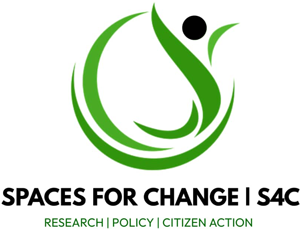
The National Bureau of Statistics (NBS) has revised the definition and methodology for computing unemployment statistics in Nigeria. Spaces for Change’s Cletus Ogwuche joined stakeholders drawn from the public and private sectors of the Nigerian economy at the Wednesday, May 14, 2015’s press briefing held in Abuja, Nigeria, where the NBS presented the revised unemployment guideline to the public.
A Review Committee inaugurated by Dr. Yemi Kale, the Statistician General of the Federation in September 2014 determined the appropriateness of the NBS’ unemployment definition and proffered a suitable one within internationally agreed parameters. Spaces for Change served as a member of this Review Committee headed by Professor Sarah Anyanwu. The Committee comprised independent experts from members of academia, public sector agencies, development partners, non-governmental organizations, trade unions and other pressure groups, including the Nigeria Labour Congress, National Youth Council, Trade Union Congress of Nigeria, Manufacturers’ Association of Nigeria, Nigeria Economic Society and National Statistical Association.
“It is our responsibility to ensure data as important as it is for growth and development isn’t mixed with ideology or emotions (either for or against). It is also our responsibility to ensure that the data produced is purely technical and devoid of sentiments, complies with internationally-accepted norms, credible, reliable and understood,” Dr. Yemi Kale said. Reechoing NBS’ commitment to the generation of reliable and credible data that speaks to our local environment, Mrs. Sarah Anyanwu added that the recent review was not only necessary to facilitate the formulation of employment policies, but also to provide “quality data for economic planning and development in Nigeria; for international comparative analysis; for the achievement of the government’s Transformation Agenda of poverty reduction, wealth creation and employment generation; and serves as a policy tool for incoming government for job creation and employment reduction in Nigeria.”
For over 45 years, employment statistics in Nigeria have been generated through the Labour Force Survey, first conducted in 1966/67 by the National Manpower Board with technical support from the then Federal Office of Statistics (FOS), which metamorphosed into the NBS. Through this survey, FOS (now NBS) generates data for determining the labour force population, number of economically active population, number of employed persons and unemployment rate. The unemployment rate is particularly significant because it provides an empirical basis for carefully considering the proportion of the labour force that is unemployed. In making this determination, the NBS has traditionally followed the International Labour Organisation’s (ILO) principles, which pegs 40 hours per week as the benchmark for all persons to be considered employed. Within the Nigerian context, Mrs. Anyanwu explained that this would mean that “any person in the labour force who did not work for up to 40 hours during reference week is considered to be unemployed. If strictly applied, those working for 39 hours a week would still be regarded as unemployed. Because the 40 hours cutoff mark is not in accord with current social and economic realities, it has constantly elicited public outcry and criticism by planning stakeholders. This inadequacy of the ILO cut-off mark informed NBS’s proposal to revise and develop appropriate statistical standards and methodologies that is reflective of the local situation and conditions in Nigeria, while still satisfying international best practices.
In light of the above, NBS’ redefinition further reduces the indicator for calculating unemployment rate from 40 hours to 20 hours a week, a new regime that recognizes the labour contributions of both skilled and unskilled workers based on the number of hours they put in, usually assessed by the last 7 days preceding the survey. This new methodology calculates unemployment by looking at the workforce population between the ages of 18 and 64 that are willing and able to work but cannot find work at least 20 hours in a week.. This analysis significantly shifts Nigeria’s official unemployment rate which currently stands at 23.9 per cent to 6.4%. It is further hoped that this review will guide the development of social and economic policies that facilitate the translation of the high national GDP into commensurate growth in employment.
